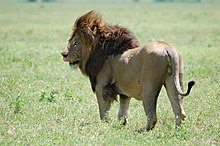Masai lion
| Masai lion | |
|---|---|
 |
|
| Male Masai lion at Ngorongoro, Tanzania | |
 |
|
| Masai lioness at Samburu, Kenya | |
| Scientific classification | |
| Kingdom: | Animalia |
| Phylum: | Chordata |
| Class: | Mammalia |
| Order: | Carnivora |
| Family: | Felidae |
| Genus: | Panthera |
| Species: | P. leo |
| Subspecies: | P. l. nubica |
| Trinomial name | |
|
Panthera leo nubica (Blainville, 1843) |
|
The Masai lion or East African lion (Panthera leo nubica syn. Panthera leo massaica) is a lion subspecies in eastern Africa. The type specimen is described as being from "Nubia". The subspecies includes previously recognized subspecies like massaica, which was initially described from the Tanganyika Territory in Eastern Africa.
Neumann first described the Masai lion as being less cobby with longer legs and less curved backs than other lion subspecies. Males have moderate tufts of hair on the knee joint, and their manes are not full but look like combed backwards.
Male East African lions are generally 2.5–3.0 metres (8.2–9.8 feet) long including the tail. Lionesses are generally smaller, at only 2.3–2.6 metres (7.5–8.5 feet). Lions, male or female, have a shoulder height of 0.9–1.10 metres (3.0–3.6 feet). In weight, males are generally 145–205 kg (320–452 pounds), and females are 100–165 kg (220–364 pounds).
A male near Mount Kenya weighed 272 kg (600 pounds) (Nowell and Jackson, 1996). As such, it would have been heavier than average Southern African lions (Kalahari, Southeast or Southwest African lions) that weighed under 230 kg (510 pounds), but not any exceptionally large Southern African lion that weighed above 272 kilogrammes.
Male Masai lions are known for a great range of mane types. Mane development is related to age: older males have more extensive manes than younger ones; manes continue to grow up to the age of four to five years, long after lions have become sexually mature. Males living in the highlands above 800 m (2,600 ft) altitude develop heavier manes than lions in the more humid and warmer lowlands of eastern and northern Kenya. The latter have scanty manes, or are even completely maneless.
The Masai lion was first described on the basis of observations in northern Uganda, near Kavirondo and in southern Kenya, as well as near Lake Manyara, around Mount Kilimanjaro and in the Tanga Region.
...
Wikipedia
